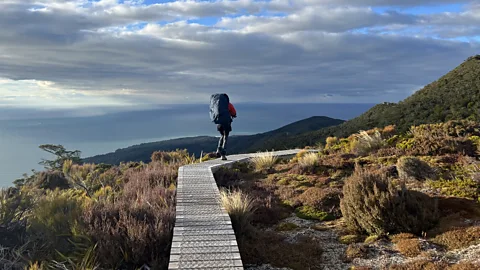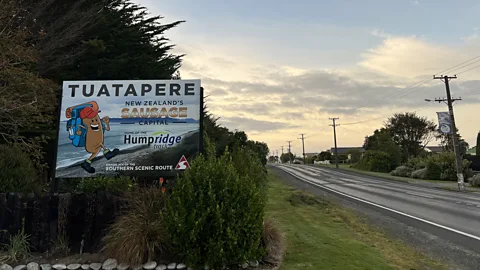Why New Zealand’s newest Great Walk is so important
 Jessica Wynne Lockhart
Jessica Wynne LockhartSituated in the country’s isolated south-west region, the Hump Ridge Track will officially launch in October 2024 and has the potential to save the tiny town of Tuatapere.
My first gasp was for breath, as I dropped my sweaty pack down on the trail, having finally reached the ridgeline. I’d spent the morning climbing roughly 900m on the Hump Ridge Track, at times relying on my hands to pull myself up through forests of dripping moss, rimu and manuka trees.
The second gasp, though, was for the view of New Zealand’s rugged south-west coast. From the rocky outcrop where I stood, one of the Southland region's most untouched corners spread out as far as I could see. In the distance was the wide crescent of sand I’d hiked along earlier that day; a reminder of how far I’d come. And above it all, a rainbow heralded my arrival into the subalpine terrain, an environment favoured by endemic kea and kākā parrots.
Locals will be quick to tell you that these are the views that inspired the Carpenters’ 1972 hit Top of the World, which was based on a poem sent to the American pop duo by a Southland schoolteacher:
Such a feelin's comin' over me
There is wonder in most everything I see
Not a cloud in the sky; got the sun in my eyes
And I won't be surprised if it's a dream
Perhaps it’s an anecdote that’s shared so often because it’s the closest brush with fame that the tiny town of Tuatapere – situated in the far reaches of Southland, the country's southernmost region – has had, well, maybe ever. The farming community’s only other claim to fame is that it’s the "sausage capital of NZ". It nearly lost that title in 2015 when the local butcher shop closed – yet another empty shopfront in a struggling town.
But all that’s about to change.
 Jessica Wynne Lockhart
Jessica Wynne LockhartIn October 2024, Tuatapere’s Hump Ridge Track will officially become New Zealand’s newest Great Walk, putting the agricultural town where the track starts firmly on the tourism map.
How to book
New Zealand’s Great Walks can be booked through DOC’s booking portal, with spots for the Great Walks season ahead – which lasts from October to April – typically opening in May or June.
The exception is the community-owned Hump Ridge Track. Even after becoming a Great Walk in October 2024, walks will continue to be booked through the track’s dedicated website. Bookings – included for guided walks and luxury add-ons, such as helicopter pack transfers and jetboat rides – may be made up to a year in advance. Bookings start from NZ$395 for the full three-day walk, with the option to add-on extras such as jetboat rides and guided walks.
Among New Zealand's most sought-after experiences, the Great Walks are a collection of 11 multi-day hiking routes traversing some of the country’s most iconic landscapes, from the volcanic craters of Tongariro National Park to the golden-hued beaches of Abel Tasman National Park. Accommodation along the track must be booked in advance with the Department of Conservation (DOC), with spots on the more popular tracks selling out faster than Glastonbury.
For international travellers, these walks offer an accessible way to experience NZ’s backcountry. Local suppliers offer gear hire and shuttles to trailheads, while hikers stay at campsites or designated huts en route, which are staffed by DOC wardens and equipped with shared bunk rooms, gas stoves and drop toilets.
And for some of the country’s most isolated rural communities – many of which are at risk of disappearing due to economic hardship – they offer a bid at survival.
“Great Walks are a lifeline for some of these small communities,” said Aaron Fleming, DOC’s operations director for the southern South Island.
 Jessica Wynne Lockhart
Jessica Wynne LockhartHe pointed to the example of the Paparoa Track, the last Great Walk to open in 2019. A survey of communities in the surrounding West Coast region found that in addition to dozens of new jobs being created, there was an increase in spending of nearly NZD$3.5m from overnight visitors in the first two years.
So, in 2017, when DOC announced it was going to be adding another walk to the collection – only the second to be added in 30 years, bringing the total to 11 – competition was fierce. The frontrunner was thought to be the Queen Charlotte Track, a path winding through the isolated bays and alongside the emerald waters of the Marlborough Sounds, which is visited by 35,000 people annually.
But in the end, it was Tuatapere’s Hump Ridge Track that won the bid, with DOC investing NZD$7.9m to bring the existing 61km loop up to a Great Walks standard. Upgrades on the trail began in 2022, including realignment of the track, the construction of new steps and boardwalks to ease gradients, and the installation of interpretative signage in consultation with the local iwi (Māori tribe), Ngāi Tahu.
Like the country’s most popular Great Walk, the Milford Track, the Hump Ridge Track traverses alpine ridgelines in Fiordland National Park, an area renowned for its snow-capped peaks, waterfalls cascading directly into the sea, ancient rainforests and deep fiords.
But that’s where the commonalities end. Unlike the Milford Track, the Hump Ridge is not untouched by civilisation. Instead, it takes place in an environment of regenerating bush. The first day is full immersion into New Zealand’s backcountry, while the second is a lesson in history, as hikers walk along heritage tramways and across some of the longest wooden viaducts in the southern hemisphere – both relics of a once-thriving forestry industry.
 Jessica Wynne Lockhart
Jessica Wynne LockhartOther points of difference? Optional perks on the three-day tramp (that’s Kiwi for “hike”) include the option to get your pack helicoptered up to the first hut, hot showers, private rooms with real beds, flush toilets and shops selling wine. (Private lodges along a handful of the tracks offer similar amenities to hikers on all-inclusive guided experiences, but the Hump Ridge is the only Great Walk where independent walkers can indulge in this fashion.)
And last but not least, it's the only Great Walk that’s community-owned and operated.
It was in the mid-1980s – when changes to government policy saw Tuatapere's forestry industry shutter and the town’s population shrink from 2,500 to less than 1,000 – that residents first bandied about the idea of opening a track to attract tourists. Designed to be walked over three days, it would carry trampers from windswept beaches high into the mountains, where they would have unrivalled 360-degree views from the top of the world of the surrounding tarns (mountain lakes), coastline and even as far away as Stewart Island/Rakiura.
Construction started in 1994, with volunteers laying the first 7km of boardwalk in just 28 days. By 2001, the track opened for business. It quickly gained a reputation as being challenging enough for the hardcore hikers, with enough options to lighten the load for newbies. But while it attracted keen Kiwis, it wasn’t enough to turn a profit.
“You can't just keep selling to Kiwis because once they’ve done it once, that’s it. You need to broaden your horizons. So, an international marketing footprint was really key for us,” said Cedric Wedderburn, the Hump Ridge Track’s general manager.
 Jessica Wynne Lockhart
Jessica Wynne LockhartAlready, its profile has been elevated by the announcement that it will become a Great Walk. Once visited by around 1,000 people annually, more than 3,000 walked the track during the 2023-2024 season. And it’s no longer just Kiwis. As I settled in beside the crackling fire on my first day – having walked from the lookout to the welcome warmth of Okaka Lodge – I met visitors from as far away as California.
More like this:
• 10 sustainable travel destinations to visit in 2024
That night, I fell into a deep sleep, my aching body cradled by a soft bed in a private room – an experience I never thought I’d have on a Great Walk. When I woke, the sunrise was casting a serene pink glow across the high-alpine tussocks. I began to trace my way along the boardwalks, but not before saying goodbye to the hut warden, Glenys Erskine-Mackie.
Born and raised in Tuatapere, the lack of job prospects forced Erskine-Mackie to leave the community when she was 18. Now, 25 years later, the track has allowed her to return.
“We used to be a really thriving community. But when the sawmills closed, the town kind of died. Shops closed and everybody in my school class moved away,” said Erskine-Mackie. “Now, there’s opportunities for people to be employed. With it becoming a Great Walk, it will drive jobs.”
That’s still to come though – and reminders of an alternate ending are evident even along the track. I spent the day descending through the green forest back to sea level, where I found Port Craig Lodge situated in what was a thriving township with a sawmill in the early 20th Century. Today though, its only residents are a pod of rare Hector’s dolphins, who playfully swim with hikers brave enough to cool off in the southern waters. As I wandered through the ghost town, I found it hard not to wonder if this could have been Tuatapere’s fate.
 Jessica Wynne Lockhart
Jessica Wynne LockhartI’m not the only one with that thought. Before I left Tuatapere, I met with volunteers from the Hump Ridge Track’s Charitable Trust, including long-time local Paula McKenzie.
“The population of Tuatapere has probably declined since they first opened the track,” said McKenzie. “But the question I would be asking is ‘what would the community be like now if we didn’t have the track?’ It feeds the community.”
With the Hump Ridge Track finally turning a profit, its Great Walk status will only help to secure the community’s future. Already, money from the track is being funnelled into other community initiatives like predator eradication programmes. Tuatapere has even been able to regain its right title as the sausage capital of New Zealand, with more than 5,000 sausages fed to trampers annually. (The track’s sewage system even had to be modified to account for the sheer number of sausages being consumed.)
I listened to the volunteers as they discussed ideas for the future. There’s no limit to what might come next – some suggested biking paths could keep visitors in the community longer. Maybe they could apply for Dark Sky certification to attract astro-tourists? And one day, maybe they could even reintroduce native takahē (an endangered flightless bird) back to the region.
First though, there’s a party to plan for October; a celebration that the community hasn’t seen the likes of since the Hump Ridge Track first opened in 2001. They’ll have to play the Carpenters, of course. The famed sausages might be served. And maybe a dance will be developed. Called “the Tuatapere Shuffle”, it will mimic stiff-legged trampers returning to town after their time at the top of the world.
Slowcomotion is a BBC Travel series that celebrates slow, self-propelled travel and invites readers to get outside and reconnect with the world in a safe and sustainable way.
--
If you liked this story, sign up for The Essential List newsletter – a handpicked selection of features, videos and can't-miss news, delivered to your inbox twice a week.
